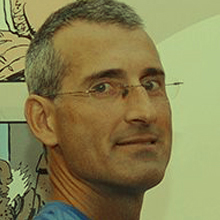Tengo el honor de presentarles uno de los más premiados humoristas gráficos a nivel internacional últimamente: Asier Sanz, nacido en Bilbao, España, en 1969. Lamentablemente, no lo conozco personalmente. Y digo así, porque admiro mucho su trabajo y eso siempre provoca el deseo de ser amigo de un grande del humor.
Y como trabajo el fotomontaje humorístico y él el collage en sus caricaturas personales, en mi imaginación lo encuentro cercano. Es por eso que además de ser un honor hacer este vis a vis con él, sea también un enorme placer.
Adelanto que es un as dibujando, un as creando humor y un as como artista y persona. Por tal motivo a partir de ahora sus respuestas se señalarán como “AS” (Asier Sanz).
Comencemos entonces…
PP: Asier, no es para evitarme trabajo, ni para hacerte sufrir, porque sé que no es fácil hablar de uno mismo, pero me gustaría que te presentaras profesionalmente, ya que quizás algún humornauta de nuestro sitio humorsapien.com no te conoce.
ASIER: Soy un humorista gráfico, ilustrador y artista del collage. Tengo 53 años y llevo 33 años, desde 1989 publicando mis trabajos en diferentes medios de comunicación en España y en el extranjero. Además de mis publicaciones en solitario, en 2000 con mi amigo el guionista Javier Gamboa creamos la pareja de humor gráfico "Asier y Javier" con la que hemos seguido publicando en periódicos y revistas, y actualmente firmamos la tira diaria de actualidad en los tres periódicos del Grupo Noticias de Euskadi. Desde 2017 me dedico también a hacer collages-caricaturas de personajes famosos con los que me han galardonado con premios en Italia, Bélgica, Brasil, España... También he ilustrado once libros. No me considero un Homo sapiens sino un Homo ludens (hombre que juega).
PP: Eres Homo sapiens, Homo ludens e Ingeniosus homo. Pero para ir conociéndote más, ¿ha variado, ha evolucionado, tu forma de hacer humor desde tus inicios hasta este momento?
ASIER: Sí, claro, ahora tengo un montón de recursos que de joven no tenía. El mundo absurdo en el que vivimos me ha ido afilando la mirada y es más fácil ver de qué pie cojean las cosas. Técnicamente sigo dibujando mojando la plumilla en el tintero como siempre, solo que desde hace años el color en vez de aplicarlo con acuarela lo doy en Photoshop. Creativamente mi modus operandi ha cambiado. Cuando empecé buscaba una certeza y luego todo se llenaba de dudas. Y ahora comienzo desde una duda y poco a poco voy llegando a una certeza. En nuestro trabajo es fundamental evolucionar. El estancamiento genera aburrimiento.
PP: Estoy de acuerdo contigo. Necesito cambiar casi constantemente en la creación. Ser así hace la vida profesional más entretenida, más intensa. Y hablando de eso, ¿cuál ha sido el mejor y el peor momento en tu carrera dentro del humor?
ASIER: El mejor momento de mi carrera fue en 2017 cuando hice mi primer collage-caricatura de Trump con mortadela y banana que se hizo mundialmente viral y fue elegida la mejor portada del mundo, estuvo expuesta en el Design Museum de Londres, amén de ser publicada en programas de TV de muchos países, revistas, etc... Un collage que me descubrió un nuevo camino creativo.
El peor momento ha sido cuando cierran un periódico en el que estás colaborando diariamente como fue el caso de “Diario16” en 2002 y el Diario Metro en 2009. También fue duro tomar la decisión junto con otros dibujantes de “El Jueves” de abandonar esta revista en solidaridad con los dibujantes que publicaron una portada que fue censurada por la propia editorial, fue muy doloroso, llevaba diez años colaborando con ellos. Hay que volver a empezar, enviar currículums a otros periódicos para a ver si te fichan... Pero no hay mal que por bien no venga. La incertidumbre es lo más creativo que existe.
PP: Toda la razón, parece clisé (y quizás lo sea), pero es cierto que de las crisis uno renace creativamente con mayor fuerza y contundencia. Y como mencionaste tu solidaridad con tus colegas, te quiero preguntar: ¿crees que tienes influencia definida, clara, de colegas españoles vivos o históricos? ¿Y de colegas extranjeros?
ASIER: De mis colegas españoles, no sé si tengo influencias, pero soy muy fan de El Roto, Chumy Chúmez, Forges... y otros muchos más. De colegas extranjeros amo a Quino, Sempé y Steinberg: son de otra galaxia. Trato de aprender de todos. Hacer humor es como hacer magia sin que se note el truco, así que trato como un aprendiz de mago de entender los mecanismos de la magia de todos los colegas que admiro.
PP: Eres un prestidigitador en el humor y un “prestigiador” del humor, sin dudas. Tu obra sorprende gratamente siempre. Te has especializado en caricaturas personales y en humor general. Entonces, ¿cuál te es más difícil de hacer? ¿Con cuál de ellos disfrutas más en tu creación? ¿Cuáles son las diferencias entre ambas?
ASIER: La caricatura y el humor gráfico son dos disciplinas diferentes aunque las dos tienen cosas en común: llegar a la máxima síntesis, es decir, no andar por las ramas, llegar a la raíz de las cosas. En ambas el proceso creativo es distinto. En los collages-caricatura lo que hago es dibujar con objetos y cada objeto tiene una intención en la forma y en el fondo. Es maravilloso descubrir elementos que antes no estaban conectados y crear una realidad alternativa. Es una disciplina que apela a mi niño interior y me hace disfrutar mucho.
Cuando hago una viñeta de humor lo que hago es desenmascarar, quitar las capas de cebolla... se trata de señalar todo lo que es importante para bajarlo del pedestal. Salir de la ceguera. Las viñetas señalan errores. Es como el cuento de “El Traje del Emperador”; el humorista señala que el rey está desnudo. La labor del humor es apuntar la desnudez. A partir de aquí lo importante es dar con el concepto.
PP: Diferencias bien entre caricatura y viñeta de humor, por ello te pregunto: ¿crees que la caricatura personal, la viñeta editorial, la llamada caricatura o caricatura de humor en general, la tira cómica, el cómic, la fotografía de humor (y sus modalidades dentro de ella), etc., son formas que están contenidas dentro de un gran “paraguas” llamado humor gráfico? ¿O todas o algunas no caen dentro de este concepto?
ASIER: El humor gráfico es la representación de cualquier situación mediante el uso de caricaturas, historietas o tiras cómicas, con la finalidad de hacer pensar al lector sobre su entorno o de abrir sus ojos frente a una realidad, para esto se puede dividir el humor gráfico en diversos tipos, relacionados con la finalidad del mismo, bien sea para diversión, para dar a conocer una realidad o por crítica social. Aunque para mí el humor gráfico tiene que tener un sentido transgresor, que lleve a algo más que la simple risa, el simple valor higiénico. Para mí la sátira tiene que estar del lado de una mejor comprensión de las cosas.
PP: No coincidimos exactamente, pero eso sería tema para otra oportunidad, café mediante. Pero sí me gustaría preguntarte: ¿el humor es un arte? Me refiero sobre todo a su característica de “parásito”, ya que sólo aparece dentro de un arte (gráfico, musical, escénico, etcétera).
ASIER: Para mí el humor es un arte y como todo arte cumple una función comunicativa, mediante la cual se expresan ideas, emociones y, en general, una visión del mundo. Y dependiendo de las manos en las que caiga es un ARTE en mayúsculas.
PP: Es cierto, todo lo que se haga dentro del universo del humor gráfico (para seguir mencionando esta modalidad, pero sirve a todas), es ARTE con mayúsculas. Pero dejemos la densidad de la teoría. ¿Cómo? Pues preguntándote: ¿podrías contar una anécdota (graciosa, ingeniosa, curiosa, o especial), que hayas vivido dentro de tu carrera en el humor, ya sea en la creación, en tus presentaciones, en tu relación con colegas, etc.?
ASIER: Desde hace 32 años dibujo la tira post-partido de todos los partidos oficiales que juega el Athletic Club de Bilbao y son publicadas en el periódico “Deia”. En 2013 cuando la directiva echó al entrenador argentino del Athletic, Marcelo Bielsa apodado "El Loco", al que admiro mucho, fui hasta el hotel donde se hospedaba y le regalé un álbum recopilatorio de la histórica campaña 2011-2012 que nos llevó a jugar dos finales, con todas los cómics que había publicado en el periódico. Casualmente estaba en el salón del hotel así que se lo di en mano. Todo muy rápido y escueto, me dio las gracias. Me despedí rápidamente para no molestarle ni invadir su espacio. Yo nunca había hablado con él. Lo curioso es que una semana después yendo en el asiento de atrás de un coche por la autopista recibo una llamada en mi móvil y era ¡¡¡Marcelo Bielsa!!! ¡Yo estaba absolutamente sorprendido! ¿Quién le había dado mi número de móvil? El caso es que me llamaba para decirme que había leído el libro que le regalé "Athletic, Karajo 2011-2012" y para darme las gracias en especial por la última tira que le había dedicado y me confesó que le había ayudado a llevar los momentos tan amargos que estaba viviendo por tener que abandonar Bilbao. Le contesté que era todo un honor que se tomara la molestia de llamarme y que estaba muy agradecido por sus palabras. Vi que íbamos a meternos en un túnel de la autopista y le advertí: "Marcelo, perdona si se corta la llamada pero es que voy en coche y vamos a atravesar un túnel". A lo que respondió: "Mejor así". Y efectivamente al meternos dentro del túnel se cortó la llamada. Fue una llamada mágica, breve pero imborrable que me dejó huella por su humanidad y humildad.
PP: Me encantó la anécdota, porque soy viudo de Bielsa. Ya sabes que dirigió el equipo de Chile. Su forma de dirigir, más su cultura y humanidad me cautivaron. Pero sigamos en lo nuestro. ¿Cómo ves la salud del humor gráfico en la actualidad? Es decir, ¿hay suficientes espacios para publicar?
ASIER: En España hay un gran nivel de humor gráfico con profesionales muy top. El problema actual es que hay muy pocos espacios para publicar. ¡Lo más difícil de hacer un chiste es que te paguen! Por eso hay que buscar otros canales y las redes sociales son un buen campo para sembrar, abonar el terreno, para luego recoger. Yo a raíz de que algunos collages-caricaturas se hicieron virales ha sido la posibilidad que me conozcan fuera de mi país y colaborar en revistas y periódicos de Brasil, Francia, Alemania, Italia, Australia...
PP: Lo tuyo no es suerte, sino mucho talento, Maestro. Pero es cierto que hay mucha escasez de espacios. Y buenos colegas tienen que buscar la salida de sus obras como pueden. Por ejemplo, participando en concursos internacionales. A propósito, ¿ves mucha diferencia entre el humor creado para los concursos y el creado para publicar en diarios, revistas, etc.? ¿Hay suficiente público consumidor?
ASIER: Lo bueno que tiene presentarse a un concurso de humor gráfico es que tienes tiempo para enviar un trabajo de calidad. Te puedes organizar, tomar el tiempo para dar con una buena idea y pulirla hasta tratar de que brille como un diamante. Luego que consiga premio o no es otra cosa. Pero por lo menos sabes que has invertido tu tiempo en hacer algo que vale la pena. Sin embargo si publicas todos los días una tira en la prensa, siempre es sobre la candente actualidad, hay que dibujarla rápido y puede haber algún bajón de calidad, porque es muy difícil acertar siempre.
Yo creo que sí hay público consumidor de humor, lo que pasa es que con Internet se está acostumbrando a que todo es gratis y hace que no proliferen las revistas de humor.
PP: Pasemos a un punto desagradable, pero que debemos tocar siempre: ¿existe mucha censura en los medios estatales y privados? ¿Mucha censura de lo políticamente correcto? En tu caso, ¿hay autocensura?
ASIER: Sí, hay autocensura, cada medio de comunicación tiene su línea editorial y unas líneas rojas que no debes traspasar. Pero la labor del humorista gráfico es luchar por seguir ampliando los márgenes de la libertad de expresión. Lo políticamente correcto es un cáncer. Durante siglos, la sátira social y política ha servido para denunciar las injusticias más atroces y para desenmascarar el lado más grotesco de la naturaleza humana... pero hoy es más difícil hacer humor que hace unos años. Estamos en la era de los ofendiditos. El humor no debiera tener límites. También pienso que el humor debe ir unido a la ética. La libertad de expresión es un poder y como dice Spiderman, todo poder conlleva una responsabilidad. Todos hemos participado del monstruo que nos devora; somos corresponsales de la realidad en que vivimos.
PP: De nuevo coincidimos, Asier. Pero, lamentablemente, debemos ir terminando este vis a vis. Así que me gustaría saber, ¿qué le aconsejarías a los que se inician en este mundo del humor gráfico? ¿Qué le dirías a todo el que admira tu trabajo? ¿Y a los que no les gusta?
ASIER: Es todo un privilegio que tu pasión sea tu trabajo, así que luchad con todas vuestras fuerzas para que hacer realidad vuestros sueños. Una meta sin un plan, es simplemente un deseo, así que un sueño se convierte en una meta cuando se toman medidas para su logro: trabajar duro, tener confianza, creer en uno mismo, fortaleza mental, moverse y enviar tus creaciones a revistas, periódicos, diarios digitales... Insistir, persistir, resistir y nunca desistir. ¡Hasta la victoria, siempre!
A la gente que admira mi trabajo decirle que tengo sobrecarga de agradecimiento en mi corazón: gracias, gracias, gracias, gracias, gracias... ¡Muchas gracias por hacerme feliz!. Esto de ser dibujante es una labor muy solitaria. A veces pienso que el dibujante es como un náufrago en su isla de la mesa de dibujo, donde desde allí lanza mensajes dentro de una botella y es muy gratificante que desde otra orilla alguien abra la botella, lea el mensaje y lo valore.
En un trabajo como este en el que siempre doy mi opinión de las cosas es complicado que a todo el mundo le guste, cada cual tiene sus creencias. Y mi objetivo no es contentar a todo el mundo. Lo malo es que en las redes sociales hay mucha falta de respeto. Internet es como un trasnochado cabaret infinito y sin puertas en el que pueden entrar todos y hay barra libre. Les diría que un poco de respeto y tolerancia que es la base para vivir en sociedad. Ser humorista gráfico se ha convertido en una profesión de alto riesgo.
PP: Exacto. Y nos decimos: “bueno, no le demos importancia a esos que viven en las cloacas de las redes sociales vomitando odio y mal gusto”, pero como tenemos que publicar ahí, es casi imposible no ver esas asquerosidades y no podemos evitar que de alguna manera nos afecte, ¿no es cierto?. Pero bueno, como dice mi hijo: “es lo que hay”… Asier, algo que me encantaría saber: dentro del humor, ¿qué te gustaría hacer que no hayas hecho? (Incluso puede ser hasta incursionar en otras modalidades).
ASIER: Mi aspiración es seguir aprendiendo, evolucionando y creciendo. Lo verdaderamente importante es superarse a sí mismo. Ahora estoy muy centrado en seguir creciendo en el universo del collage. ¡Ojalá pueda descubrir nuevos universos!
PP: Por último, ¿hay alguna pregunta que no te haya hecho y que te hubiera gustado que te hiciera? Si es así, ¿puedes responderla ahora?
ASIER: Todo OK… Muchas gracias Pepe por la entrevista y por tu gran creatividad que nos regalas habitualmente. Eres un ejemplo a seguir. Gracias a los lectores por tomarse el tiempo de leer estas líneas. ¡Abrazo gigante!
PP: Te juro que es un honor recibir esas palabras generosísimas de parte de alguien que tanto admiro. ¿Qué puedo decirte? Solo desearte mucha salud, mucha suerte y muchos éxitos más, y agradecerte profundamente tu tiempo y esfuerzo por acompañarme en este vis a vis. ¡Otro abrazo enorme para ti!
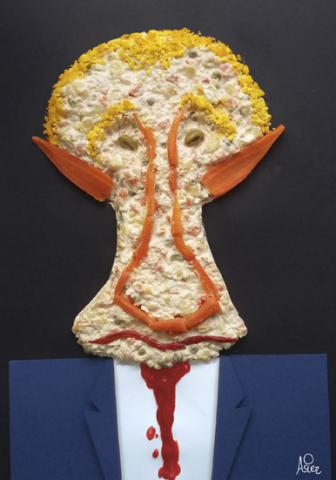
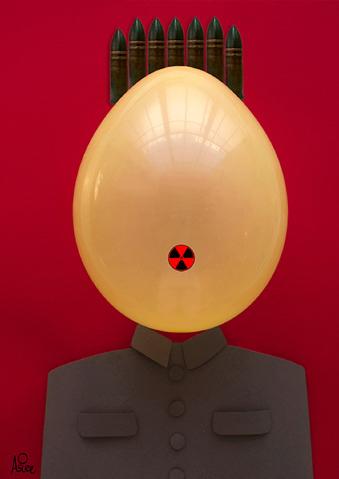
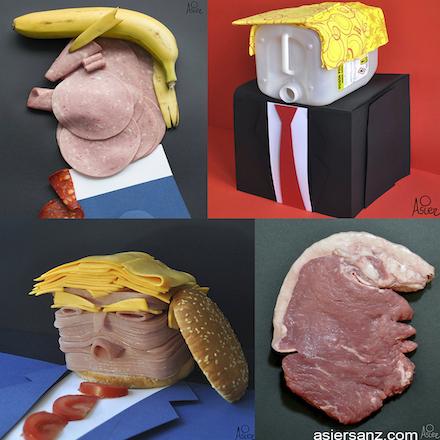
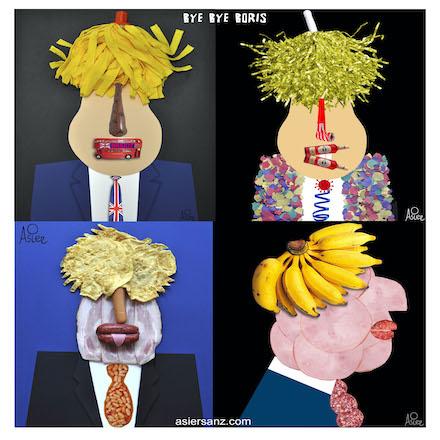
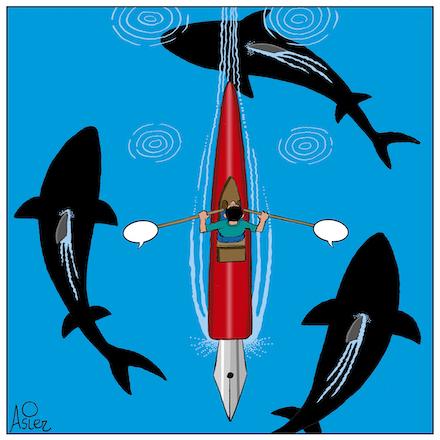
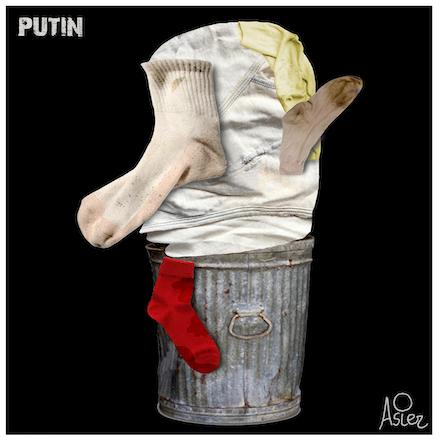
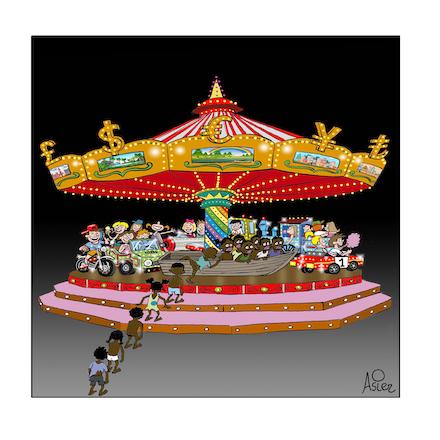
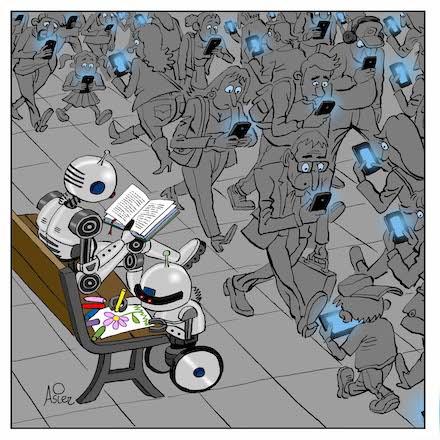
Interview with Asier Sanz
By Pepe Pelayo
Humor must go together with ethics
I have the honor of introducing you to one of the most awarded international cartoonists recently: Asier Sanz, born in Bilbao, Spain, in 1969. Unfortunately, I do not know him personally. And I say that, because I greatly admire his work and that always makes me want to be friends with a great comedian.
And since I work with humorous photomontage and he works with collage in his personal caricatures, in my imagination I find him close. That is why, in addition to being an honor to “talk” with him, it is also a huge pleasure.
I anticipate that he is an ace at drawing, an ace at creating humor and an ace as an artist and person. For this reason, from now on your answers will be marked as “AS” (Asier Sanz).
Let's start then...
PP: Asier, it is not to save me work, nor to make you suffer, because I know that it is not easy to talk about yourself, but I would like you to introduce yourself professionally, since perhaps some humornaut from our site humorsapien.com does not know you.
ASIER: I am a cartoonist, illustrator and collage artist. I am 53 years old and I have been publishing my works in different media in Spain and abroad for 33 years, since 1989. In addition to my solo publications, in 2000 with my friend the screenwriter Javier Gamboa we created the graphic humor couple "Asier and Javier" with which we have continued publishing in newspapers and magazines, and currently we sign the daily current affairs strip in the three newspapers from the Euskadi News Group. Since 2017 I have also dedicated myself to making collages-caricatures of famous people with which I have been awarded prizes in Italy, Belgium, Brazil, Spain... I have also illustrated eleven books. I do not consider myself a Homo sapiens but a Homo ludens (man who plays).
PP: You are Homo sapiens, Homo ludens and Ingeniosus homo. But to get to know you more, has your way of doing humor changed, evolved, from your beginnings to this moment?
ASIER: Yes, of course, now I have a lot of resources that I didn't have when I was young. The absurd world in which we live has sharpened my vision and it is easier to see where things are limping. Technically, I continue drawing by dipping the pen in the inkwell as always, except that for years now, instead of applying it with watercolor, I have applied it in Photoshop. Creatively my modus operandi has changed. When I started I was looking for certainty and then everything was filled with doubts. And now I start from a doubt and little by little I am reaching a certainty. In our work it is essential to evolve. Stagnation generates boredom.
PP: I agree with you. I need to change almost constantly in creation. Being like this makes professional life more entertaining, more intense. And speaking of that, what has been the best and worst moment in your career in humor?
ASIER: The best moment of my career was in 2017 when I made my first collage-caricature of Trump with mortadella and banana that went worldwide viral and was chosen as the best cover in the world. It was exhibited at the Design Museum in London, in addition to being published in TV programs in many countries, magazines, etc... A collage that discovered a new creative path for me.
The worst moment has been when they close a newspaper in which you are collaborating daily, as was the case with “Diario16” in 2002 and Diario Metro in 2009. It was also hard to make the decision along with other cartoonists from “El Jueves” to abandon this magazine in solidarity with the cartoonists who published a cover that was censored by the publisher itself, it was very painful, I had been collaborating with them for ten years. You have to start over, send resumes to other newspapers to see if they sign you... But there's no silver lining. Uncertainty is the most creative thing there is.
PP: Absolutely right, it seems cliché (and perhaps it is), but it is true that from crises one is reborn creatively with greater strength and forcefulness. And since you mentioned your solidarity with your colleagues, I want to ask you: do you think you have a defined, clear influence from living or historical Spanish colleagues? And from foreign colleagues?
ASIER: From my Spanish colleagues, I don't know if I have influences, but I am a big fan of El Roto, Chumy Chúmez, Forges... and many others. As for foreign colleagues, I love Quino, Sempé and Steinberg: they are from another galaxy. I try to learn from everyone. Doing humor is like doing magic without the trick being noticed, so I try like a magician's apprentice to understand the mechanisms of the magic of all the colleagues I admire.
PP: You are a conjurer of humor and a “prestigitator” of humor, without a doubt. Your work always pleasantly surprises. You have specialized in personal caricatures and general humor. So, which one is harder for you to do? Which of them do you enjoy most in your creation? What are the differences between both?
ASIER: Caricature and graphic humor are two different disciplines although they both have things in common: reaching the maximum synthesis, that is, not beating around the bush, getting to the root of things. In both the creative process is different. In collages-cartoons what I do is draw with objects and each object has an intention in form and background. It's wonderful to discover elements that were previously unconnected and create an alternate reality. It is a discipline that appeals to my inner child and makes me enjoy it a lot.
When I make a humorous cartoon, what I do is unmask, remove the layers of onion... it's about pointing out everything that is important to take it down from the pedestal. Get out of blindness. The bullets point out errors. It's like the story of “The Emperor's Suit”; the comedian points out that the king is naked. The job of humor is to point out the nudity. From here the important thing is to find the concept.
PP: You differentiate well between a caricature and a humorous cartoon, which is why I ask you: do you think that the personal caricature, the editorial cartoon, the so-called caricature or humorous caricature in general, the comic strip, the comic, the humorous photograph (and its modalities within it), etc., are forms that are contained within a large “umbrella” called graphic humor? Or do all or some of them not fall within this concept?
ASIER: Graphic humor is the representation of any situation through the use of caricatures, comics or comic strips, with the purpose of making the reader think about their environment or to open their eyes to a reality, for this humor can be divided graphic in various types, related to its purpose, whether for fun, to publicize a reality or for social criticism. Although for me graphic humor has to have a transgressive meaning, leading to something more than simple laughter, simple hygienic value. For me, satire has to be on the side of a better understanding of things.
PP: We don't exactly agree, but that would be a topic for another opportunity, coffee through. But I would like to ask you: is humor an art? I am referring above all to its “parasitic” characteristic, since it only appears within an art (graphic, musical, scenic, etc.).
ASIER: For me, humor is an art and like all art it fulfills a communicative function, through which ideas, emotions and, in general, a vision of the world are expressed. And depending on the hands it falls into, it is an ART in capital letters.
PP: It is true, everything that is done within the universe of graphic humor (to continue mentioning this modality, but it works for all), is ART with capital letters. But let's leave the density of the theory. As? Well, asking yourself: could you tell an anecdote (funny, witty, curious, or special), that you have experienced within your career in humor, whether in creation, in your presentations, in your relationship with colleagues, etc.?
ASIER: For 32 years I have been drawing the post-match strip for all the official matches played by Athletic Club de Bilbao and they are published in the newspaper “Deia”. In 2013, when the board fired Athletic's Argentine coach, Marcelo Bielsa, nicknamed "El Loco", whom I admire a lot, I went to the hotel where he was staying and gave him a compilation album of the historic 2011-2012 campaign that led us to play two endings, with all the comics he had published in the newspaper. Coincidentally, he was in the hotel lounge so I handed it to him. Everything was very quick and concise, he thanked me. I said goodbye quickly so as not to disturb him or invade his space. I had never spoken to him. The funny thing is that a week later, while riding in the back seat of a car on the highway, I received a call on my cell phone and it was Marcelo Bielsa!!! I was absolutely surprised! Who had given him my mobile number? The fact is that he called me to tell me that he had read the book that I gave him "Athletic, Karajo 2011-2012" and to thank me especially for the last strip that I had dedicated to him and he confessed that it had helped him manage the moments so bitter that I was experiencing having to leave Bilbao. I replied that it was an honor that he took the time to call me and that I was very grateful for his words. I saw that we were going to enter a highway tunnel and I warned him: "Marcelo, sorry if the call is cut off but I'm going by car and we are going to go through a tunnel." To which he replied: "Better this way." And indeed when we entered the tunnel the call was cut off. It was a magical call, brief but indelible that left its mark on me for its humanity and humility.
PP: I loved the anecdote, because I am Bielsa's widower. You already know that he led the Chile team. His way of directing, plus his culture and humanity captivated me. But let's continue doing our thing. How do you see the health of graphic humor today? That is, are there enough spaces to publish?
ASIER: In Spain there is a high level of graphic humor with very top professionals. The current problem is that there are very few spaces to publish. The hardest thing about making a joke is getting paid! That is why you have to look for other channels and social networks are a good field to sow, fertilize the land, and then harvest. As a result of some collages-cartoons going viral, it has been possible for me to be known outside my country and to collaborate in magazines and newspapers in Brazil, France, Germany, Italy, Australia...
PP: Yours is not luck, but a lot of talent, Master. But it is true that there is a great shortage of spaces. And good colleagues have to find a way out of their works as best they can. For example, participating in international competitions. By the way, do you see much difference between the humor created for contests and that created to publish in newspapers, magazines, etc.? Is there enough consumer public?
ASIER: The good thing about entering a graphic humor contest is that you have time to send quality work. You can organize yourself, take the time to come up with a good idea and polish it until you try to make it shine like a diamond. Then whether he gets a prize or not is another thing. But at least you know that you have invested your time in doing something worthwhile. However, if you publish a strip in the press every day, it is always about the hot news, you have to draw it quickly and there may be some drop in quality, because it is very difficult to always get it right.
I believe that there is a public that consumes humor, what happens is that with the Internet they are getting used to the fact that everything is free and it prevents humor magazines from proliferating.
PP: Let's move on to an unpleasant point, but one that we must always touch on: is there a lot of censorship in state and private media? Much censorship of political correctness? In your case, is there self-censorship?
ASIER: Yes, there is self-censorship, each media outlet has its editorial line and some red lines that you should not cross. But the job of the cartoonist is to fight to continue expanding the margins of freedom of expression. Political correctness is a cancer. For centuries, social and political satire has served to denounce the most atrocious injustices and to unmask the most grotesque side of human nature... but today it is more difficult to make humor than it was a few years ago. We are in the era of the offended. Humor should have no limits. I also think that humor should be linked to ethics. Freedom of expression is a power and as Spiderman says, with power comes responsibility. We have all participated in the monster that devours us; We are correspondents of the reality in which we live.
PP: We agree again, Asier. But, unfortunately, we must finish the interview. So I would like to know, what would you advise to those who are starting out in this world of graphic humor? What would you say to everyone who admires your work? And those who don't like it?
ASIER: It is a privilege that your passion is your work, so fight with all your strength to make your dreams come true. A goal without a plan is simply a wish, so a dream becomes a goal when you take steps to achieve it: work hard, have confidence, believe in yourself, mental strength, move and submit your creations to magazines, newspapers, digital newspapers... Insist, persist, resist and never give up. Ever onward to victory!
To the people who admire my work, tell them that I have an overload of gratitude in my heart: thank you, thank you, thank you, thank you, thank you... Thank you very much for making me happy! Being a cartoonist is a very lonely job. Sometimes I think that the artist is like a castaway on his island of the drawing table, where from there he sends messages into a bottle and it is very gratifying that from another shore someone opens the bottle, reads the message and appreciates it.
In a job like this where I always give my opinion on things, it is difficult for everyone to like it, everyone has their beliefs. And my goal is not to please everyone. The bad thing is that there is a lot of disrespect on social networks. The Internet is like an endless, outdated cabaret without doors where everyone can enter and there is an open bar. I would tell them that a little respect and tolerance is the basis for living in society. Being a cartoonist has become a high-risk profession.
PP: Exactly. And we tell ourselves: “well, let's not give importance to those who live in the sewers of social networks vomiting hatred and bad taste,” but since we have to publish there, it is almost impossible not to see those disgusting things and we cannot avoid that somehow way it affects us, doesn't it? But hey, as my son says: “it is what it is”… Asier, something I would love to know: within humor, what would you like to do that you haven't done? (It may even be to venture into other modalities).
ASIER: My aspiration is to continue learning, evolving and growing. The truly important thing is to improve yourself. Now I am very focused on continuing to grow in the collage universe. I hope I can discover new universes!
PP: Lastly, are there any questions I haven't asked you that you wish I had asked you? If so, can you answer it now?
ASIER: Everything OK… Thank you very much Pepe for the interview and for your great creativity that you usually give us. You are a role model. Thank you readers for taking the time to read these lines. Big hug!
PP: I swear it is an honor to receive such generous words from someone I admire so much. What can I say? I just wish you good health, good luck and many more successes, and thank you deeply for your time and effort in joining me in this exchange. Another huge hug for you!
(This text has been translated into English by Google Translate)

